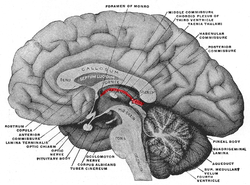Epithalamus
| Epithalamus | |
|---|---|
 Mesal aspect of a brain sectioned in the median sagittal plane. Epithalamus labeled in red, by 'habenular commissure', 'pineal body', and 'posterior commissure', with its projection anteriorly consisting stria medullaris | |
| Details | |
| Identifiers | |
| Latin | epithalamus |
| MeSH | A08.186.211.577.200 |
| NeuroNames | hier-275 |
| NeuroLex ID | Epithalamus |
| TA |
A14.1.08.002 A14.1.08.501 |
| FMA | 62009 |
The epithalamus is a (dorsal) posterior segment of the diencephalon. The diencephalon is a part of the forebrain that also contains the thalamus, the hypothalamus and pituitary gland.[1] The epithalamus includes the habenula and their interconnecting fibers the habenular commissure, the stria medullaris and the pineal gland.
Functions
The function of the epithalamus is to connect the limbic system to other parts of the brain. Some functions of its components include the secretion of melatonin and secretion of hormones from pituitary gland by the pineal gland (involved in circadian rhythms), and regulation of motor pathways and emotions.
Components
The epithalamus comprises the habenular trigone, the pineal gland, and the habenular commissure. It is wired with the limbic system and basal ganglia.
Species that possess a photoreceptive parapineal organ show asymmetry in the epithalmus at the habenula, to the left (dorsal).[2]
References
External links
- http://isc.temple.edu/neuroanatomy/lab/atlas/pdhn/
- NIF Search - Epithalamus via the Neuroscience Information Framework